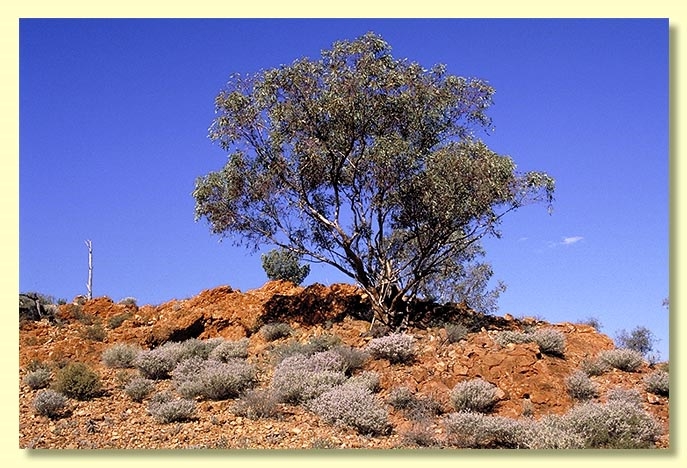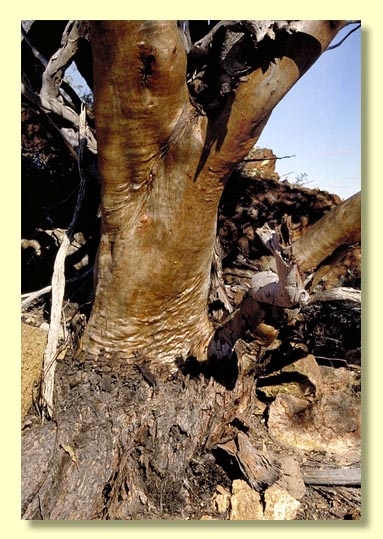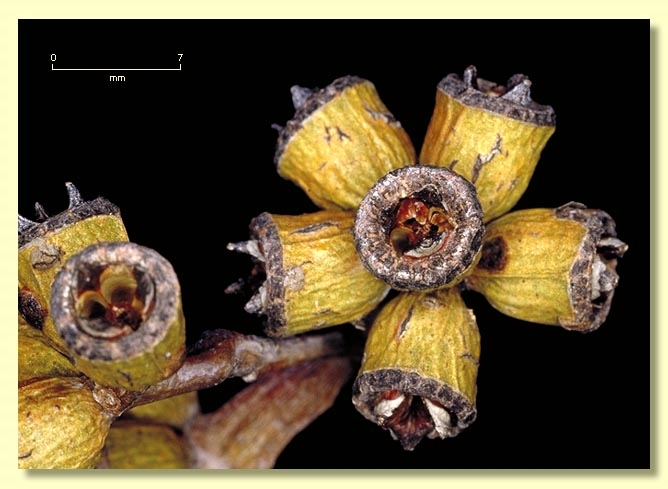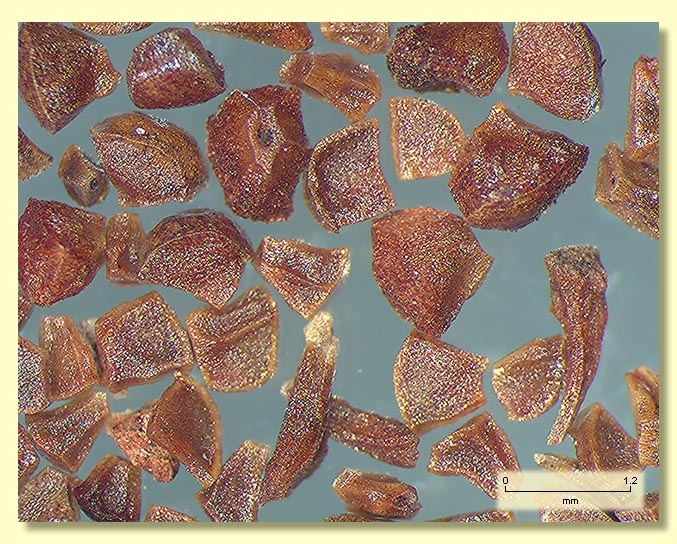Euclid - Online edition
Eucalyptus carnei
Eucalyptus | Symphyomyrtus | Bisectae | Glandulosae | Stricklandianae
T: near Sandstone, W.A., 19 July 1927, C.A.Gardner s.n.; holo: PERTH.
Bark smooth throughout, grey over coppery, pinkish or cream, sometimes a short (ca 0.5 m) stocking of crumbly to flaky rough grey-black bark present.
Branchlets glaucous; oil glands present in the pith.
Juvenile growth (coppice or field seedlings to 50 cm): stems rounded in cross-section, glaucous or not; juvenile leaves always petiolate, alternate, lanceolate, 8–11 cm long, 1.7–3 cm wide, dull, grey-green.
Adult leaves alternate, petiole 1.3–2.3 cm long; blade lanceolate, 8.3–14.5 cm long, 1.5–3 cm wide, base tapering to petiole, margin entire, apex pointed, dull, grey-green, side-veins greater than 45° to midrib, reticulation moderate to dense, intramarginal vein remote from margin, oil glands irregularly shaped, intersectional, or obscure.
Inflorescence axillary unbranched, peduncles flattened, glaucous, (0.5)0.7–2 cm long, buds 7 per umbel, sessile or scarcely pedicellate (pedicels 0–0.1 cm long). Mature buds obovoid to broadly fusiform (0.9–1.3 cm long, 0.5–0.6 cm wide), non-glaucous, scar present, operculum rounded to bluntly conical, stamens inflexed, rarely a few stamens only terminally deflexed, anthers oblong, versatile, sub-basifixed, dehiscing by longitudinal slits, style long and straight, stigma blunt to rounded, locules 3(4), the placentae each with 4 vertical rows of ovules. Flowers creamy white.
Fruit sessile, cupular to obconical, 0.5–1 cm long, 0.6–0.9 cm wide, disc level or descending usually obliquely, valves 3(4), prominently exserted or near rim level.
Seeds mid-brown to red-brown, glossy, 1–2.2 mm long, pyramidal, with two seedcoats, dorsal surface smooth, hilum terminal.
Cultivated seedlings (measured at ca node 10): cotyledons Y-shaped (bisected); stems rounded in cross-section, slightly warty; leaves always petiolate, opposite for 4 to 8 nodes, lanceolate to broadly lanceolate, 6–13 cm long, 1.7–4 cm wide, dull, grey-green.
Flowering has been recorded in April and May.
A small tree or mallee endemic to Western Australia, found in the northern goldfields, east from Sandstone and Meekatharra, extending into the Great Victoria Desert to the east of Lake Rason, on stony slopes. The bark is smooth or rough at the base while the upper smooth bark seasons to coppery, branchlets are glaucous and the pith strongly glandular. Oil glands in the leaves are very irregular. The buds are characteristically flared around the middle.
Eucalyptus carnei belongs to Eucalyptus subgenus Symphyomyrtus section Bisectae subsection Glandulosae because the cotyledons are bisected, buds have an operculum scar and the branchlets have oil glands in the pith. Within this subsection (of ca 80 species) E. carnei is only closely related to one other species, E. stricklandii, and together they form series Stricklandianae. E. stricklandii has a more southerly distribution than E. carnei. Leaves, buds and fruit are smaller in E. carnei, as is stature. E. carnei has creamy white flowers whilst E. stricklandii has yellow flowers.
Eucalyptus carnei: after Walter Mervyn Carne (1885–1952). Walter Carne spent the first part of his career lecturing at the Hawkesbury Agricultural College, New South Wales. After World War 1, 1923–1928, he was Economic Botanist and Plant Pathologist for the Department of Agriculture, Western Australia and from 1929 to 1936, he was employed by CSIRO as a Senior Plant Pathologist. He was eventually seconded to the Commonwealth Department of Commerce and stayed there until his retirement in 1950. Amongst other distinctions, he received the Gold Medal of the Royal Society of Western Australia for his research into the diseases of apples and allied fruits.














